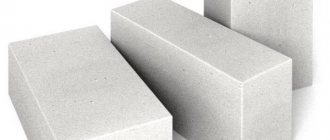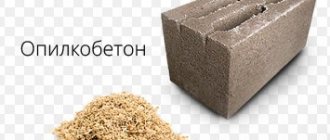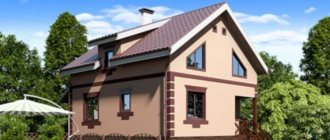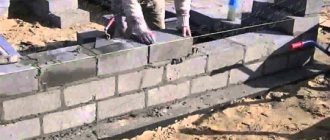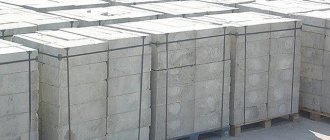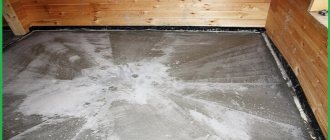It's time to renovate your apartment, but you're still hesitating to start because you haven't decided what finish to use for the walls? The easiest way is to paint the walls, and it will also look very impressive if you approach the work correctly and pay enough attention to each stage.
Scheme for filling joints.
Painting concrete walls with your own hands is a fairly economical option; you do not have to spend a lot of money on this venture.
To realize your idea, you only need to buy the right paint and brushes of the right size.
In order for the result to be worthy, you need to work hard and follow certain recommendations. The preparation of concrete walls is of particular importance. Features of the preparatory stage depend on the type of base available. Most often you have to work with a concrete surface.
Start by checking that the walls are dry before painting. If necessary, you will need to remove the old layer of paint with a spatula; sometimes alkali is used for this purpose. The base must be thoroughly cleaned of dirt. You can remove fat using a 5% soda ash solution. Rust can be removed with water, as well as priming with copper sulfate. However, it is better to purchase drugs that are ready for use.
Treating walls before wallpapering
Friends, today we will talk about how to treat a wall before wallpapering. However, in order to fully cover the topic, we will also touch on such a topic as preparing walls for wallpapering.
If you are thinking about wallpapering, then you are probably also thinking about how to properly prepare the walls for wallpapering, because the base is a very important point.
It is worth understanding that preparing walls for gluing is half the journey. If your walls are crooked, with cracks, holes and bumps, then no matter what wallpaper you put on them, it will look bad. It’s better to hang wallpaper at a cheaper price, but take a thorough approach to the process of preparing the walls, than to buy expensive wallpaper and at the same time spend time on the preparatory stage.
Proper painting of concrete walls: how and with what to paint indoors and outdoors
Painting concrete walls is a simple, affordable, effective and aesthetic option for finishing this type of surface. Despite the fact that the process is relatively simple and all stages of the work can be completed independently, to get the best result it is advisable to prepare - stock up on the necessary tools, understand the composition of the paint, and learn about the features of wall preparation.
Before painting concrete walls, you need to think carefully about everything - the composition is selected taking into account the operating conditions and functions of the room, the location of the wall (inside/outside the building), and personal wishes. The concrete monolith is prepared for painting - the old layers of finishing are removed, putty and primer are applied. Only after this can you begin to apply paint with a special tool.
The most popular and suitable compositions for painting concrete are discussed below, and the order of tasks is determined. If you have a minimum of knowledge and skills, doing everything quickly and efficiently will not be difficult.
How to paint: tips and tricks
Before deciding how and with what to paint concrete walls, you need to study everything carefully. The experts give fairly simple and effective recommendations to avoid common mistakes and achieve an ideal surface.
Things to remember while performing work:
- It is advisable to carry out all stages wearing safety glasses and, if necessary, a respirator. This way it is possible to avoid dust and microparticles of the dye from getting into the lungs, and to protect yourself from the pungent odor of the composition.
- All tools are prepared before work begins - the brushes are fluffed and checked for the presence of bristles, the rollers are soaked under a powerful stream of water, then wrung out and leveled. All packaging is removed, the instrument is neatly folded in an accessible place.
- The ceiling and floor at the joints with the wall are protected with masking tape - it will easily come off after all the work is completed. Then, if necessary, some places can be carefully touched with a thin brush.
- Concrete paint for walls is applied in a perfectly thin, uniform layer. A wall that was painted in three neat thin layers looks much more aesthetically pleasing and beautiful than one thick layer, which causes streaks to appear.
- Puttying of concrete walls is usually carried out in two layers: first with cement/gypsum plaster, then with a special finishing putty. This technology allows you to achieve a perfectly smooth coating.
- Each layer of paint is applied only after the previous one has completely dried.
- If the wall is new, then work can begin only after 28 days have passed from the moment of pouring.
Material selection
When deciding what paint to paint concrete walls, you need to consider a lot of factors. First of all, they consider the main varieties, their advantages and disadvantages, compliance with the functions of the room, and cost.
When deciding how to paint a concrete wall outdoors, they give preference to synthetic and durable compounds that are not afraid of moisture, sudden temperature changes, and sunlight. But for an apartment, it is better to choose environmentally friendly paint based on natural oils or water - here external negative factors will not affect the surface, but it is very important to choose an option that is safe for health.
The purpose of the room where painting is carried out is also important. So, for the kitchen and bathroom, moisture-resistant compounds are chosen, but for the bedroom or living room, acrylic-based interior paint is also quite suitable. Moscow and the regions today offer a fairly large selection of materials on the market, so choosing the right one will not be difficult.
Oil paints
This type of composition is usually used when deciding what to paint a concrete wall on a balcony or on the street. This is the best option for outdoor work, since the paint is quite toxic and has an unpleasant odor, which then takes a long time to dissipate.
Main advantages of paint:
- Availability in terms of price
- High level of resistance to moisture, temperature, various external factors
- Excellent coating strength, durability
- Simple and easy care – the paint can be washed even with cleaning agents
Among the disadvantages of oil compositions, it is worth mentioning the long drying time (at least a day), low level of elasticity and the risk of cracks, color instability (due to drying oil turning yellow over time).
Water based
Aqueous dispersions and emulsions are ideal for painting concrete walls in an apartment. The materials do not contain toxic elements and are often used for finishing interior surfaces. Only some types are designed specifically for covering facades, which must be indicated on the label and instructions.
The cost of the paint is relatively low - the price is an order of magnitude higher compared to oil-based compositions, but within reason.
Acrylic
This type of material is relevant for performing different types of work - paint for concrete walls is used both outside and inside. The packaging must have a mark indicating the operating conditions of the composition - covering the internal wall, facade, ceiling, etc. (Be sure to specify when choosing). Acrylic paints are often used even for European fences and for artistic wall painting.
The main advantages of an acrylic-based composition:
- Environmental friendliness and safety
- Ability to achieve any shade and color
- Vapor permeability
- Resistance to external negative factors, mechanical influences
- Preservation of color for a long time without changes in tone
- Good elasticity of the coating
The paints are not cheap, but they offer an ideal ratio of quality and price, which is why they are popular in the market for repair and construction materials.
Silicate
This concrete paint is made on the basis of liquid glass. The resulting coating is very durable and reliable, so the composition is often used for finishing facades.
The main advantages of silicate paints:
- Resistance to any type of chemical attack - acid rain, reagents, etc.
- Fire resistance
- Long-lasting color retention
- Biological resistance - the composition does not allow fungi and mold to multiply
Rubber paints are often chosen for exterior finishing. Epoxy paints are relevant for concrete floors, as they are not afraid of external influences. If you need to protect a building from destruction and fire, choose fire-resistant compounds. But textured or textured concrete paint for interior walls will be an excellent decor.
Impregnation for concrete
Before painting, it is advisable to coat the wall with a special product. A protective layer of impregnation will protect the surface from dust, moisture, and various aggressive environments. Impregnation penetrates into the very structure of the material, strengthening it. Impregnations are produced based on epoxy resins, polyurethane, acrylic, and other substances.
Paint color
When choosing a color for painting concrete, we are guided by the classical rules of design: light colors make the space visually larger and wider, dark colors make it narrower and smaller. All colors are divided into shades of the warm and cold spectrum.
There are a huge variety of options for any color - only white is presented in dozens, or even hundreds. The choice is made on the object, applying palettes to the surface and assessing the play of light, imagining the space in the imagination or modeling the room using special programs.
Working with the surface
Many craftsmen advise paying serious attention to the question of how to prepare a concrete wall for painting. New surfaces may only require the application of impregnations and primers; old surfaces may only require the removal of layers of paint and varnish compositions, repairs, leveling, putty, etc.
How to prepare walls for wallpaper
Let's try to go step by step along the way of preparing the walls for wallpapering.
- First of all, you need to rid your walls of any dirt and old material, be it wallpaper, whitewash, plaster that is not holding up well, and so on.
- Next, your walls should be coated with a primer.
- Now you can move on to plaster. Plaster is applied in order to rid your walls of changes, level them and remove large defects. It is worth understanding that those rooms where there is excess moisture and temperature changes, such as the kitchen, bathroom, toilet, balcony and loggia, should be covered only with cement plaster. Gypsum plaster is used in all other cases for interior work. This is because gypsum is an unstable material, as it absorbs moisture and tends to expand.
- Next, it is advisable to cover the walls with putty, a thin layer of which will ensure evenness and smoothness and eliminate minor defects.
- The next stage of preparing the walls is cleaning. It is necessary to thoroughly clean the walls and give them a finished look. Such walls will be completely ready for any type of decorative covering, be it wallpaper, paint or other decor.
Painting procedure
The tile covering must be carefully prepared. Clean the surface of any dirt, paying special attention to the cracks. Ideally, the work area should be washed with a mini-washer using high pressure. You can use an industrial vacuum cleaner to remove dust.
Before painting, the tiles must be washed. If you don't have a mini-wash, you can use a regular garden hose. After washing, the surface should dry well.
The paint must be prepared in accordance with the manufacturer's instructions. Professional tilers advise diluting the first layer with a 20% solution of mineral turpentine to increase adhesion. It is advisable to use a roller to apply paint.
The second and subsequent layers are applied without adding turpentine. Before each new layer, you must wait until the coating has completely dried.
The drying time should also be indicated in the instructions for the selected paint. If the coloring agent has been standing for a long time, it must be thoroughly mixed before use to avoid changing the shade.
After applying the finishing coat, it is recommended not to walk on the paving slabs for 2-3 days so that the paint coating is completely dry. This nuance should be taken into account at the preparation stage by equipping additional routes for moving around the territory.
How to treat walls before wallpapering
- If your walls have been thoroughly prepared, the final step before wallpapering is priming the walls. The walls are primed to ensure good adhesion so that your wallpaper sticks well to the walls.
- If your walls have been painted and you plan to cover them with wallpaper, then it is advisable to treat them with concrete contact - this is a high-performance primer. It will provide your walls with the right layer, loosen the paint and prevent it from falling off along with your wallpaper.
- If your walls were prepared a long time ago and mold has formed under the old wallpaper, then after removing the mold you need to treat the walls with antiseptics, which will provide you with confidence that mold will stop growing under the new wallpaper. It is worth understanding that in order to combat mold, it is necessary to remove the old plaster in places where mold was noticed and then repair this place. The fact is that mold eats into the plaster and simply wallpapering the room cannot be saved.
Conclusions on the topic
Thus, we considered the topic of treating walls before wallpapering, and also paid attention to the topic of preparing walls for wallpaper. There is no need to neglect these works, since they determine how beautiful your renovation will ultimately look. If the walls are crooked, then after arranging the furniture you will be surprised how this will interfere with the appearance of being holistic. All the holes and bumps on the walls will not work in your favor. The treatment of your walls with a primer will determine how well the wallpaper will stick to the walls. This is especially true for rooms where there is a problem with excess moisture or temperature changes.
If this article helped you but you still have questions, you can ask them in the comments, and our users or authors will be happy to help you solve your problem.
Preparing the priming mixture
The primer before wallpapering is prepared using the instructions that the manufacturer places on the packaging.
Primer in factory packaging is most often supplied ready-made and already prepared for use. Stir this mixture well enough. If necessary (for processing reinforced concrete bases), walls under wallpaper are primed with less concentrated compounds; for this, acrylic primers are diluted with water, and alkyd primers with white spirit.
Concentrated primers are adjusted to the required consistency according to the manufacturer's recommendations.
To dilute the dry concentrate, you will need a deep container, a mixer and the solvent provided in the instructions. The powder is poured into water and brought to a homogeneous state; a properly prepared primer should not have lumps.
What is it for?
To ensure that the wallpaper does not peel off or become deformed during work, and that the canvas lays evenly on the wall, the walls must be leveled before gluing the wallpaper.
Wall treatment provides protection against mold, fungal spores and bedbugs.
Many walls have a finely porous structure, which allows air to accumulate in the pores , which contributes to the unraveling of wallpaper seams. To prevent this from happening, it is necessary to ensure maximum adhesion between the wallpaper and the wall.
Wallpaper glued to unprepared walls will not last long and is aesthetically unattractive.
When can you glue?
It is recommended to cover the walls with decorative material only after completing all of the above work, which includes:
- eliminating visual elements on the surface;
- primer;
- plaster;
- putty.
Once the walls have a perfectly flat surface, you can begin gluing.
In addition to preparing the surface, it is also necessary to observe the temperature regime - it should not be lower than 5 degrees Celsius. Before gluing, you need to tightly close the windows and doors in the room to prevent drafts.
Preparing the surface for gluing is not a very difficult task, as it may seem at first glance, but it must be done. The main thing for this work is to use high-quality material, show attention and patience.
Source: otdelkasten.com
What should the surface be?
If you carry out the preparatory work correctly before wallpapering, you can meet the necessary requirements for the wall for wallpaper:
- Uniform color and cleanliness of the walls (if the wallpaper is light in color or not dense enough, any stains on the wall can show through).
- Strength (a wall is considered strong if, when running a key or similar object across it, dust and small crumbs do not fall off).
- Dryness (glue will not be able to absorb into a wet surface, due to which it will lose its adhesive properties).
- Without lime stains (places where lime accumulates may be damp, therefore, do not absorb the glue: in these places the wallpaper will peel off).
Features of painting any concrete surface
Painting buildings located in the open air and intended for industrial work requires preliminary strengthening of the concrete surface and cleaning it from dust and dirt. This will allow you to get a high-quality result.
Wall painting scheme.
All concrete walls are exposed to moisture. The use of impregnation significantly reduces its impact on the wall and protects the structure from premature destruction. The use of fluate solution is recommended during the preparatory stage for painting concrete products for indoor and outdoor use. This prevents the appearance of white spots on their surface.
The applied paint coating is intended to protect concrete from the influence of external factors that destroy the structure.
When working with any type of paint, before applying it to concrete, it should be filtered and stirred periodically during painting. If you don't do this, the end result may not be what you expected.
There are many industrial water-based paints for concrete, which may increase humidity when used. This must be taken into account at high humidity. Painting should be carried out at a concrete surface temperature above 5°C.
Optimal weather for outdoor work is cloudy, dry, with light wind. It is not recommended to paint the concrete surface if it is heated by sunlight. The wrong time to work is in the evening. Morning or evening dew, falling on a freshly painted surface, spoils all the work.
Features of wall treatment depending on their material
Before achieving the desired wall surface for wallpapering, it is necessary to carry out a number of works that will help bring the surface to ideal condition . The specifics of preparing walls for wallpaper largely depend on what material the wall is made of.
Nuances when processing walls made of different materials:
- Drywall has a smooth surface, but it is porous and not strong enough. During processing, special attention should be paid to leveling the surface, taking into account joints and screws.
- Concrete walls are the most durable. Since their structure has minimal porosity, sometimes it is enough to apply only a primer for preparation.
- Brick walls are not strong and level enough, so to process them it is necessary to go through several stages (leveling, puttying, priming).
- Chipboard walls have screws and joints. They need to be covered with oil paint. Next, the surface is treated in the usual way.
- Treating OSB walls for wallpaper is practically no different from preparing brick walls. Only the first stage is sealing the seams with the mixture and covering the wall with serpyanka.
Almost any covering can be prepared for gluing in such a way that the quality of the wallpaper will no longer depend .
Flow calculation
Primer consumption is influenced by many factors, so you should not rely solely on the rate per square meter recommended by the manufacturer. Increases consumption:
- increased indoor air temperature;
- surface structure (degree of porosity).
When calculating the required volume of material, you should follow the manufacturer’s recommendations, but there are average primer consumption rates for various surfaces:
- concrete surfaces – 350 g/m2;
- drywall, gypsum plasterboard, OSB and gypsum plasterboard sheets – 120 g/m2;
- plaster for painting – 100 g/m2;
- wooden surfaces, including plywood – 120 g/m2;
- metal surfaces – up to 120 g/m2.
The specified standards are indicative indicators, but in the absence of exact data, they can be used to determine the required amount of priming solution.
How to do everything with your own hands?
At first glance, preparing walls for wallpapering seems like a fairly easy task. However, there are nuances that a non-professional may not always be aware of.
Removing old coating
If the walls are covered with old wallpaper or paint, then before pasting the wall, it is necessary to remove the old decor.
Old wallpaper can be pasted in several layers, so before eliminating it, you must first spray the wall with water. Then use a spatula to remove the old layer.
Old paint is much more difficult to remove from walls. There are three ways to remove old paint:
Plaster
Plastering of walls is carried out in order to level the surface and eliminate its gross defects . Modern gypsum plaster can be applied to the wall in a layer of up to 7 mm, which is very convenient for leveling.
Prepare the mixture and spatula for work. Fill in the depressions and cracks with putty, knock down the protrusions and bulges as much as possible, and smooth out the remaining unevenness with the compound.
If the wall is uneven (has a slope), then you can level it using beacons, a level and rules.
Having placed the beacons, it is recommended to initially spray the wall with a more liquid putty solution, and then begin applying the main mixture.
After have completely dried, you can proceed to puttying the surface.
Puttying is one of the mandatory steps that must be performed when preparing walls for wallpapering. A putty solution is produced with a consistency that is easy to apply to the surface.
Using a circular motion of the spatula, apply the mixture to the wall in several stages, and the layer should not exceed 4 mm. Hard-to-reach places (radiator, pipes) must be puttied with a rubber spatula.
The final layer of putty is applied most carefully so that there are as few irregularities as possible.
Do you know how to deal with mold on the wall in an apartment? Detailed information is here.
Getting rid of mold, fungi, bedbugs
mandatory to treat the walls against fungi, mold and bedbugs before wallpapering even if there are no such defects on the wall and never have been.
There are several preventive and effective recipes for treating walls against mold and similar formations:
- bleach - 200 g of bleach is dissolved in a liter of water and applied to the wall;
- the fungicide, like lime, can also be diluted with water and the resulting solution can be used;
- chlorine solution (white) effectively fights fungus and its spores;
- hydrogen peroxide solution copes well with mold spores and fungus;
- a solution of copper sulfate and water (100 g per 10 liters) also effectively attacks areas of mold and fungi and protects walls from bedbugs.
If mold has appeared through the plaster, then you need to clean this piece of plaster down to the base. Treat the wall with any of the solutions. After treating the surface, it is recommended to apply a primer with an antiseptic.
Important! When working with solutions, it is necessary to use protective equipment: gloves, respirators, goggles.
By priming the walls, the consumption of adhesive is reduced, and priming also has a number of properties that have a positive effect on the final stage of finishing.
Priming result:
- the quality of gluing the wallpaper to the wall improves;
- cracking of the putty does not occur;
- ensures moisture impermeability into the wall;
- the formation and development of fungus is prevented;
- The adhesion of the wallpaper and the wall is enhanced, thereby increasing the service life of the wallpaper.
In order for the priming process to be carried out correctly, you need to know some subtleties:
- the primer is applied only to completely dry putty;
- Wallpaper should only be glued onto a completely dry primer.
Since the porosity of the wall may not be uniform, in this case the primer must be applied unevenly to the wall. A more porous surface must be treated with more mixture.
When all stages of wall treatment are correctly completed , the final result of the work will meet expectations: smooth walls, perfectly laid wallpaper, no problems with mold and bedbugs.
In the following video, see what needs to be done before wallpapering the walls:
Recommended wall thickness
A lot depends on the correct determination of this parameter. The calculation is made for each supporting structure, taking into account its purpose, the height of the house, the type of concrete and climate.
It is also important to take into account the type of exterior finishing, since some options make it possible to install an additional layer of insulation. We are talking about the so-called ventilated facades and well masonry. Installation of independent thermal insulation allows you to reduce the thickness of concrete structures and, accordingly, reduce the cost estimate.
Frameless buildings are made of strong panels, which take on the entire load. These elements are often single-layered and made of lightweight concrete, and are often immediately supplied with external finishing.
There are also so-called sandwich panels. Inside they have an insert made of insulation - the latter is pressed mineral wool.
Multi-storey buildings are usually built using a frame method. The base is either assembled from ready-made elements or poured directly on site. The walls are constructed from lightweight hollow panels, which are, in fact, permanent formwork - it is subsequently filled with dense concrete.
Houses no higher than 16 floors have external structures with a thickness of 30 to 50 cm. Internal partitions are much thinner - from 8 to 10 cm.
Low buildings are usually erected using a monolithic method. In this case, formwork is initially constructed, which is filled with light varieties of concrete that do not have high density. Here the thickness of the walls rarely exceeds 25-35 cm.
Requirements for surfaces for wallpapering
First you need to determine the criteria that the wall intended for wallpapering must meet. Not only the decorative quality of the finish, but also its durability will depend on compliance with these conditions. Therefore, the first step is to inspect the surface and determine the amount of work to be done. The walls can be checked only after the old coating has been removed from them.
After completely cleaning the walls from old decorative finishes, they must meet the following requirements:
- The walls must be dry, since a wet surface practically does not absorb water, which is the basis for wallpaper glue. In this regard, the canvases will not adhere well to the wall, and as the temperature in the room rises and moisture evaporates, the wallpaper will begin to peel off from the surface.
- Cleanliness of the base. The walls must be freed not only from old coatings, but also from possible pockets of mold (even if they are only suspected). You shouldn’t even start pasting the wall if you find suspicious dark stains or obvious colonies of some kind of microflora on it, since sooner or later they will destroy the finish and will definitely appear outside.
Wallpapering a wall like this is crazy! The surface is clearly “sick” with extensive fungal infection, and requires thorough “treatment”!
In addition, as mold grows, it releases spores into the environment that are dangerous to human health. Paper-based wallpaper is a very favorable environment for the rapid development of such colonies. And they will definitely appear under the already pasted canvases if the wall is even a little damp.
- The wall should not have cracks or other damage, as they will appear through the glued sheets. Well, with further expansion of the cracks, tears or folds from distortions may appear on the decorative coating.
- Surfaces must be even and smooth, as well as uniform in color, otherwise unevenness will definitely be visible through the wallpaper. If the selected canvases have a small thickness and are painted in light shades, then the color difference on the wall surface will certainly appear through them.
The best paints for facade work
Among the highest quality compositions, it is worth highlighting several paints.
Dulux Bindo Facade BW
This composition of domestic production is considered professional, and therefore its characteristics are at the highest level. The paint is made on a latex basis and is used for facade finishing of basement floors, walls and other things. It has the necessary moisture resistance and vapor permeability. The finished coating lasts about 10 years. During this time, the color is maintained regardless of the intensity and frequency of weather events.
The composition also contains special biocidal additives. They penetrate into concrete and prevent the formation of mold, mildew, and salts. The composition has excellent adhesion, but is quite expensive - about 5,300 rubles per 10 liters. Paint is applied in two layers. It is recommended to carry out work at a temperature not lower than +5 degrees.
Colorex Betopaint
This is a Swedish facade paint that is resistant to moisture and has good throughput. It’s also not cheap (about 5,000 for 9 liters), but it’s worth it. After applying the composition to the surface, solutions of salts, which often appear in the plaster material, are removed from it.
It is worth noting the excellent adhesion of the composition and its resistance to changes in temperature and weather. The paint is completely safe for humans (it even received the “Eco-flower” sign). However, it is worth noting that finding this composition is not so easy, since it has not yet gained much popularity.
Sherlastic Elastomeric
This is a modern flexible facade paint from an American manufacturer that creates a durable protective layer on the surface. It is packaged only in 18.3 liters (so be careful not to stumble upon a fake) and costs about 25,000 rubles. If the building is small, then this option may not be suitable. But it can also be used on fireplace surrounds, siding and other types of surfaces.
The main advantage of the composition is its high resistance to atmospheric conditions and alkalis. Thanks to this, the composition can be applied even at pH levels of 6-12. Users also note the good coverage of the composition and the fact that the paint smoothes out minor defects in the facade.
Tex Profi façade (acrylate)
The composition is sold in the form of a transparent dispersion. The cost is quite affordable, about 2,300 rubles for a 9-liter container (though you will have to spend money on the color scheme). The composition is excellent for concrete bases, brickwork, and plastered surfaces. Also, paint can be safely applied to an already painted facade, but only on condition that the old layer adheres well and does not have serious defects.
Consumers are well acquainted with the products of this company and appreciate them for their quality, lack of unpleasant odor, ease of application and optimal price. In addition, the composition is moisture resistant and dries quickly (in the warm season, drying occurs in about an hour). At the same time, the treated facade can be washed without any problems, but do not overuse it, as the paint will begin to wear off. It is also worth noting good adhesion.
Removing old coating
Before proceeding with the treatment of the wall, you will first need to remove the old material. If wallpaper has been pasted, it can be removed using a spatula and a damp sponge. Wet the coating, and after that it will easily come off the wall.
If the wall has been painted, remove the paint with a stiff wire brush. In cases where the paint adheres firmly, simply wash it with water and sand it.
If there are cracks in the ceiling
Scheme of the construction of a two-layer concrete wall.
Often, in a room where concrete walls need to be painted, the ceiling is in poor condition. And the biggest defect is considered to be cracks. They should be worked on separately. First, you should remove the fallen particles from such cracks, and then eliminate them using putty. To do this, apply the paste to the crack with a small spatula, spread it thoroughly, remove excess, and level it. Cracks should not be noticeable. Thus, all irregularities need to be processed. To wash the walls, use any detergent. It is known that when applying paint to a dirty wall, the coating will quickly crack.
Return to contents
Stages of preparing walls for taping
How to prepare walls for wallpapering? Work on preparing walls for gluing consists of several sequential technological processes.
- The preparatory stage that completes construction and installation work in a new building. There must be: the work of laying the floor screed has been completed; electrical wiring completed; door (window) frame installed; Built-in furniture is installed.
- Old wallpaper and paint are removed from the walls, nails and screws are removed.
- The quality of old plaster is checked by tapping it with a hammer. When dull sounds appear, the wall is cleared of the plaster layer.
- Chips and peeling are repaired, microcracks are repaired.
- The walls are washed if necessary (oil stains, soot, dirt are washed off).
- A primer is applied to create good adhesion between the wall and the plaster layer.
- Beacons are displayed.
- The walls are plastered with cement-sand mortar.
- The applied plaster layer is primed and putty is applied.
- The final stage of preparation is priming the surface for taping with trellises.
How to protect against mold
If the room is damp, there is a high risk of mold, which can ruin all the repairs done. But fortunately, there are several ways to avoid this:
- Apply a bleach solution. In order to prepare it, you will need to mix 200 grams of bleach and 1 liter of water. Treat the wall with this mixture, and you will provide yourself with protection against mold, fungi and other bacteria for a long time;
- treat with fungicide. In hardware stores you can find special glue with a fungicide added, so you can combine protection against mold and directly wallpapering.


